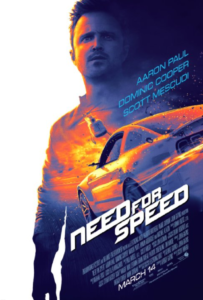If we learn anything from the illogical and largely joyless “Need for Speed” it is that no matter how good a driver you are, a car is a deadly weapon. It’s a shame that the movie isn’t more self-aware and, if the filmmaker really wanted to throw caution to the winds, he could have made it just a little less deathly serious.
“Need for Speed” is the latest video game adaptation to grace the big screen. And like the others before it, the movie isn’t nearly as fun as the game. A complete failure? No. The core demographic will likely support it on opening weekend. But non-gamers, beware.
“Speed” follows street racer Tobey Marshall (Aaron Paul) as he goes from local underground celebrity to nationally infamous. After a street race gone wrong that leaves his best friend dead, Tobey spends a couple years in prison. He emerges hellbent on revenge and using a car to get it. I guess he hasn’t learned his lesson–prison hasn’t rehabilitated him.
Although he’s on parole, Tobey is able freely jump back behind the wheel. Little attention is paid to what parole means–he’s not fitted with an ankle monitor and moves about freely with little consequence aside from a casual mention that he’s “jumping parole.” It would have been interesting to see him at least try to walk the straight and narrow and deal with life without fast cars, but “Need for Speed” isn’t interested in drama.
To exact his revenge on the racer who is, at least, partially responsible for the death of his friend, Tobey “logically” decides to acquire a fast car and race from New York to California in hopes of gaining enough notoriety to get an invite into a special underground race known as the Deleon. The master of ceremonies for the Deleon is the shadowy Monarch (an unhinged Michael Keaton) who colorfully rules the roost from a bank of computers, a super fast Internet connection, and a microphone.
For me, the movie possesses a dearth of logic without any sort of reasonable moral compass. There is no nobility to Tobey’s quest. And even though reckless driving led to the death of his best friend, he fails to take steps to prevent that from happening as his cross-country trek leaves in its wake a trail of destruction and, at a minimum, serious injury by motor vehicle. And the cop cars that pile up, having crashed and flipped, made me wonder whether the filmmakers wanted us to think of officers of the law as faceless storm troopers. But remember, there were people under that white (and useless) armor, and the cops in their uniforms in “Need for Speed” are the only noble ones in the film.
To be fair, story and moral lessons are not the point of a film like this. Action is paramount, and the action is very well captured. Using, no doubt, and array of various cameras and an endless supply of car mounts, cinematographer Shane Hurlbut (“Act of Valor” and many others) gets it right. Too bad that the story didn’t spend more time focused on the unique talent that the drivers have and why they are driven to drive fast.
The point of view on display from the interior of the vehicle should be more than just mechanical. We need to learn more about what makes these racers tick. If the film tried to climb inside the mind as well as the car, the excitement would be much more impactful.
When describing a film about golf years ago, I remember the late great film critic Roger Ebert talked about the Zen of the game. “Need for Speed” could use a little metaphysical Zen. And it nearly does. Early on, I thought it was going to try to rise above its one-dimensional narrative origins. There are scenes starting with the first street race in which Tobey’s focus on the road ahead of him stretches outward before him and seems to warp. It is effective and even a bit trippy. But as the story unfolds, this intriguing visual and potentially emotional technique is mysteriously abandoned. Had it been given a mystical and/or emotional explanation, the film would have gained greater weight and import. As is, we get “Smokey and the Bandit” without any of the self-aware fun and nonsense. And this is really too bad, because there is chemistry between Paul and his adorable love interest played by Imogen Poots, both of whom are capable charismatic screen presences.
Without personalizing the racers and diving into some of their motivations and techniques, the racing seems a bit hollow. And this is particularly apparent during the final race where the other competitors are merely shown in glimpses. Gone are the cheesy but fun introductions of the competitors like, say, “Canonball Run.” And like the cop/storm troopers that are laid to waste during the races, “Need for Speed” doesn’t care about anyone or anything except its morally confused hero and the flawed villain. What a pity.
Finally, during an early party scene in the film, one of the characters tries pick up women by informing them that he built the sports car prominently on display. Being a mechanic fails to impress them and becomes a running joke. But the joke is on the filmmaking team, who take what amounts to a technical mechanic’s approach to story-telling instead of diving deeper than high octane and squealing tires. And, frankly, as the son of a mechanic, I found the joke offensive–gear-heads take note: “Need for Speed” thinks you’re not sexy.


